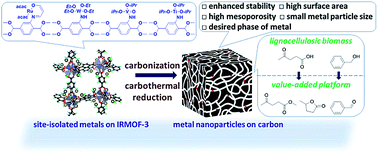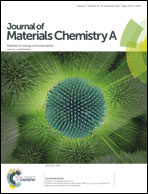Exceptional control of carbon-supported transition metal nanoparticles using metal-organic frameworks†
Abstract
This report describes a versatile method to prepare metal nanoparticles supported on nanoporous carbon (M/NC3) via carbonization and carbothermal reduction (CCR) of metal-coordinated IRMOF-3 materials by post-synthetic modification (PSM) with metal precursors (i.e., Ru, W, V, and Ti). Use of IRMOF materials as templates/carbon sources led to desirable pore characteristics in the resulting materials, including high surface area (SNLDFT, 900–2000 m2 g−1) coupled with an increased mesoporosity (Vmeso/Vpore, 0.72–0.86). Formation of carbide phase metals (V8C7 and TiCxOy) was attained at 1000 °C, which is 200–300 °C lower than preparation of these carbide phases via conventional impregnation methods. Smaller sized metal nanoparticles were successfully obtained in the M/NC3 materials compared to materials prepared with un-coordinated metal impregnated IRMOF-1 (M/NC1), primarily due to the ability of IRMOF-3 to coordinate with metal precursors via PSM, leading to site isolation and minimization of aggregation of metal nanoparticles during CCR. Moreover, this coordination provided several additional benefits such as formation of ruthenium nanoparticles without encapsulation by carbon shells and formation of a WC1−x phase with enhanced thermal stability. Furthermore, all M/NC3 materials were shown to be highly active catalysts for liquid phase conversion of model compounds and derivatives of lignocellulosic biomass.


 Please wait while we load your content...
Please wait while we load your content...